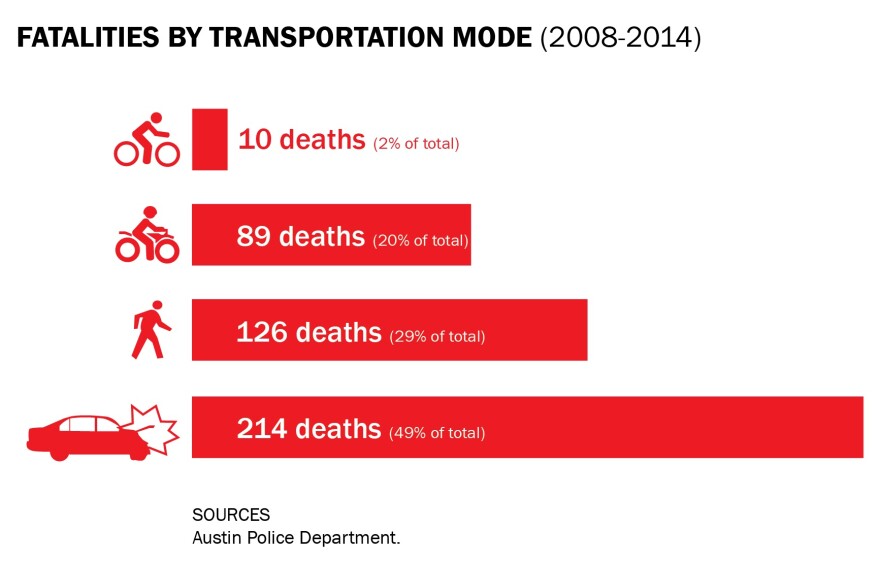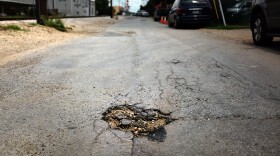Austin’s roads are more dangerous than ever. The rate of fatal car crashes is nearly double what it’s been in previous years. It’s only July, and soon the city will have more traffic fatalities so far this year than we did during all of last year. These statistics alone paint a grim picture of road safety in Austin.
But there's also a human face and voice behind each of these numbers. People like Tina-Michelle Pittsley, the victim of a near-fatal crash in Austin.
She moved to Austin in 2009 to start her own business as a fitness coach and personal trainer.
“I had a hard time keeping up with her," remembers her fiancé, Corey Butler. “She always wanted to be outside running, walking, doing active things, making experiences. That was one of things that attracted me to her in the first place.”
On Memorial Day in 2013, Pittsley was out for an afternoon run. She had one last intersection to cross before she got home.
The road wasn’t a very busy one, and it had a stop sign before the crosswalk she was about to enter. She looked both ways, saw it was clear, and continued her run.
'It Went Black'
“As I was crossing, I noticed a truck coming out of the neighborhood," Pittsley says. "He was approaching very rapidly. ”
A large black Ford F150 truck was suddenly speeding towards her.
"It went black," she says. "And I remember — no feet. There was no ground underneath me anymore.”
She blacked out. The crash impacted her head, shoulders, and legs. She came to and saw the rear tire of the truck rolling towards her face. She gathered what strength she had left and rolled out of the way. A witness stopped to help, then an ambulance and the police came.

It's been two years of surgeries, rehab and piles of medical bills they’re struggling to pay ever since. She has struggled to bounce back mentally after the crash caused a traumatic brain injury.
"Things are very different, I’m very different," she says. "There are things I want to express and I can’t even get those out. I feel like a ghost.”
Pittsley was doing everything she should have been. She was running during daylight hours, obeying traffic signals, wearing a bright pink top. There was a sidewalk, crosswalk and stop sign to get her through the intersection safely. And the driver who hit her did not show any signs of intoxication.
“It’s something I’ll always struggle with. I’ll never know what he was thinking or why he did that," she says. “Your life is at stake every time you leave the house.”
This crash doesn't mirror the statistics: most fatal crashes occur at night and on the weekends, involve intoxication, and occur on busier, high-traffic roads.
But the crash that upended her life has one thing in common with nearly all of the serious and fatal crashes in Austin and the rest of the country: it was entirely preventable and unnecessary. And what happened to Tina-Michelle Pittsley has been happening more and more on Austin’s roads, with increasingly fatal results.

'A Momentary, Selfish Act'
“There’s a lot of people that suffer when someone dies or gets seriously injured," says Art Fortune, Commander of Highway Enforcement for Austin’s Police Department (APD). When a car crashes in Austin, it's his officers that respond.
Visiting him in his office, you’ll notice a stack of papers on Fortune’s desk, ten pages front and back. This is the list he keeps of the fatal crashes in Austin. This list will likely be twice as long by the end of the year.

Fortune says they’re not sure why 2015 is seeing such a drastic rise in fatal car crashes. The numbers tend to rise and fall and rise again over the years, but this year is different, and the fatalities are rising at a rate much faster than Austin's population growth.
Intoxication is a factor in over half of the crashes, and this week the department expanded their DWI team so it’s fully-staffed seven nights a week. The police could also focus more on drivers with suspended or revoked licenses — they are driving in a quarter of fatal crashes. And prosecutors could do more — only a handful of the dozens of fatal crashes this year have become criminal cases.
Criminal charges were never filed in Tina-Michelle Pittsley's case, because it didn't involve alcohol, there were no direct police witnesses, and the driver did not flee the scene. Typically, one of those three factors has to be in evidence in order for charges to be filed by local prosecutors, Fortune says.
Distracted driving and using phones while driving are also an issue, responsible for over three thousand serious injuries a year in Texas, but APD isn’t sure that the city’s new hands-free law making it illegal to use a cellphone while driving has made any real difference.
What could make a real difference is changing driver behavior. That also happens to be the most difficult part of Fortune's job. “There's that momentary, maybe selfish act of, ‘Hey I’m going to do whatever I want to do, I don’t think there’s going to be any fatal consequences’," Fortune says. "But they take that chance, and then, of course, it’s too late.”
A Vision to Get to Zero
“I mean, a car is a wonderful thing. But it’s also a two-ton projectile — it can do an awful lot of damage. And we need to remind ourselves of that," says Art Markman, a Psychology professor at the University of Texas at Austin.
Markman studies distracted driving and behavioral change, and he argues that what could help reduce car crashes is treating reckless or impaired driving as a public health issue: Make bad driving the new smoking.
"You know, most of us don’t get into crashes most of the time," he says. "So it’s easy to lull yourself into a false sense that you are invincible. That the crashes happen to someone else. Until they happen to you.”
If the current trend continues, this will be the deadliest year for traffic fatalities in Austin's recent history.
Despite the number of rising traffic fatalities in Austin, it’s actually never been safer to drive or ride in a car in the U.S. Stronger cars, more airbags and other safety improvements like blind spot warnings and lane assist mean that technology is doing more and more of the safety work for us.
But if you’re outside of the car, the dangers haven’t changed. In fact, they’ve become worse.
People on foot make up a larger percentage of traffic fatalities than they did ten years ago, and the number of pedestrian deaths has increased as well, especially in Austin. Now some cities are trying to change that by adopting a policy called Vision Zero. It's a simple idea: any road death is too many. Austin’s city council adopted Vision Zero last fall, and will consider an action plan to begin implementing it this November.
The program began in Europe, and it's been very successful there. It utilizes education, enforcement and road engineering — like making intersections safer and slowing down speeds — to reduce fatal crashes. The idea is that crashes will still happen, but they don’t have to be fatal.
'You Assume Responsibility'
But even in non-fatal crashes like the one that hit Tina-Michelle Pittsley, the consequences can last a lifetime. She’s made significant recovery since being hit, regaining a lot of her speech and memory. She’s started doing light workouts at the gym. But she still doesn’t feel whole.
"I’m trying every day, that’s the only thing I can hang on to," she says. "I will say, I have very strong doubts. I know there are things that will be permanent from this.”
When some people hear what's happened to her, they tell Tina-Michelle she’s lucky to be alive. But she doesn’t always agree. "I try to see that point of view," she says. "But it’s hard to live like this.”
Car crashes kill nearly three times as many people as firearm homicides do in the U.S. — it's one of the top ten causes of preventable death in the country. “You get behind the wheel, you’re supposed to be responsible for your life, your passengers' lives, and the other people who are out on the road — whether or not they’re in the car or on a bike, or on a motorcycle. You assume responsibility," Pittsley says.
If the current trend continues, this will be the deadliest year for traffic fatalities in Austin’s recent history. Yet fatal crashes are somehow considered part of the price we pay for a car-dependent society. Perhaps it’s time to think differently.
Mapped: Driver-Pedestrian Crashes in Austin, 2010-2014
The map below shows every crash that involved a pedestrian in Austin from 2010 - 2014. The data comes from the Texas Department of Transportation, and was mapped by Andrew Thornton, an Interactive Visualization Developer.
The map plots the 1,476 collisions of the 1,931 total for which there was valid location data. Simply click a cluster to zoom in closer. A bright red dot indicates a fatality.
You can see the map and data of the crashes in more detail at his website, Encoding Pixels.
Learn more about Austin's Vision Zero policy here.
<



